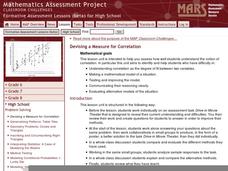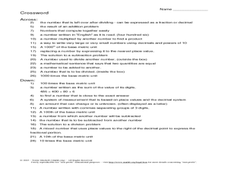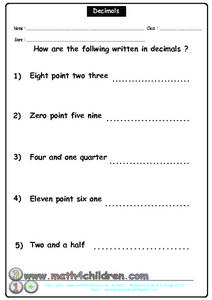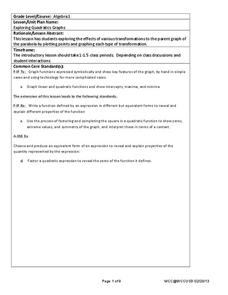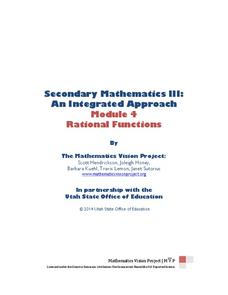Curated OER
Devising a Measure for Correlation
How well does your class understand the concept of correlation? Use an activity to explore different methods of calculating correlation. Working alone and then in groups, your class will make decisions on what math to apply to the...
Curated OER
Interactivate - Geometry in Tessellations
Students use an on-line worksheet to experiment with patterns of tessellations in regular polygons. As students observe different shapes in the "Tessellate" Activity they complete a data table and practice making predictions for...
Mathed Up!
Simultaneous Equations
How do you solve systems of linear equations? Scholars watch a video to learn how to solve systems using elimination-combination. After viewing the video, they solve seven systems of equations.
Alabama Learning Exchange
Graphing Stations
Pupils explore the concept of graphing stations. In this graphing stations lesson plan, students head to various teacher set-up stations involving slope, point-slope, standard form, parallel lines, etc. Pupils work problems at each...
Curated OER
Polynomials Degree and Finite Differences
In this algebra worksheet, students identify polynomials and state the degree and rewrite it in standard form. There are 32 questions ranging from polynomials to graphing a quadratic.
Curated OER
Iterating the Function over Real Numbers
Young scholars use a spreadsheet to find sequences of numbers. In this algebra lesson, students find the values for c of a quadratic written in standard form. They relate the behavior of the graph to the values of the equation.
Curated OER
Place Value: Numbers to 9,999
In this place value practice learning exercise, students fill in the missing numbers in the 6 place value sequences. In addition, students write 4 expanded form numbers as standard form numbers and write 4 more numbers using words.
Curated OER
Exponents
In this exponent worksheet, learners write exponential numbers in standard form, then multiply and divide exponents.
Curated OER
Va Va Va Zoooommm
Young scholars, in groups, measure a variety of physical components to several activities. They use both standard and non-standard forms of measurement and then develop conclusions about the use of units in measurement.
Curated OER
Place Value 1-- Breaking Down Numbers
For this math worksheet, students practice standard and expanded notation by solving 33 problems. Students break numbers down to tens and ones and write as addition, then reverse the process to write the standard form.
Curated OER
Crossword Puzzle: Decimals Vocabulary
In this crossword puzzle: decimals vocabulary worksheet, 6th graders fill in the puzzle using the clues and math vocabulary words.
Curated OER
Scientific Notation
In this scientific notation instructional activity, students change numbers from standard form to scientific notation and change numbers from scientific notation to standard form. This one-page instructional activity contain 15 problems.
Curated OER
Hundreds, Part 1
In this math worksheet, students examine place value models of ones, tens and hundreds. Students examine the pictures and write the numbers using words, expanded notation and standard form. There are 5 problems.
Curated OER
Place Value 5
In this place value review worksheet, students practice their math skills as they respond to 4 fill in the blank questions regarding expanded form and standard form.
Curated OER
Solving Equations by Completing the Square
In this algebra worksheet, students solve 24 quadratic equations using the process called completing the square. Students must first use mathematics to write the quadratic equation in standard form (ax^2+bx+c=0).
Curated OER
Decimal
For this decimal worksheet, 3rd graders write 5 decimals from word to standard form. They read the words, and write the numbers on the blank line next to each one.
Curated OER
Scientific Notation
For this scientific notation worksheet, students first write a set of 10 equations and answers in standard form, then another set of 10 in scientific notation.
Curated OER
Linear Modelling of the Life Expectancy of Canadians
Middle and high schoolers explore the concept of linear modelling. In this linear modelling lesson, pupils find the line of best fit for life expectancy data of Canadians. They compare life expectancies of men and women, and find the...
EngageNY
Completing the Square (part 2)
Give classes confidence in completing the square with a resource that develops the process of completing the square of more complex problems, including fractions and values greater than one. It then uses quadratic modeling for profit and...
EngageNY
Margin of Error When Estimating a Population Proportion (part 2)
Error does not mean something went wrong! Learners complete a problem from beginning to end using concepts developed throughout the last five lessons. They begin with a set of data, determine a population proportion, analyze their result...
Teach Engineering
Bone Mineral Density Math and Beer's Law
Hop into a resource on Beer's Law. A PowerPoint presentation introduces Beer's law as part of calculating bone density from X-ray images in the sixth instructional activity in the series of seven. Individuals work on practice problems...
Curated OER
Equivalent Fractions and Comparing Fractions
How can you tell if fractions have equal value? Use various collaborative activities to demonstrate the ways to determine whether or not fractions are equivalent.
West Contra Costa Unified School District
Exploring Quadratics and Graphs
Young mathematicians first graph a series of quadratic equations, and then investigate how various parts of the equation change the graph of the function in a predictable way.
Mathematics Vision Project
Module 4: Rational Functions
Time to study the most sensible function — rational functions! The seven-lesson unit develops the concept of a rational function through a connection to rational numbers and fractions. Scholars graph functions, solve equations, and...


